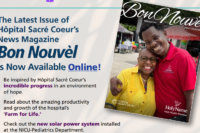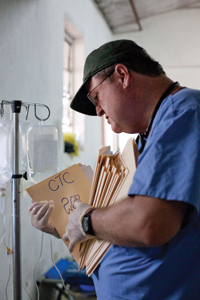 By Joseph Giere, M.D.
By Joseph Giere, M.D.
In 2010, there were almost 2,500 gynecological visits to Hôpital Sacré Coeur. Women come for the same reasons in Haiti as they do in any other part of the world. They come because they have pain. They have bleeding. They have family worries. The work demands of their children’s father does not allow for family time.
However, there is a troubling difference for Haitian women.
Haitian woman come for medical help later, sicker and with less resources than their sisters of the rich nations. As a result, the women who arrive at Hôpital Sacré Coeur for medical care present with heavier bleeding, more prolonged bleeding or with stubborn pain that refuses to respond to their usual Rx: to wait the pain out, to use home remedies, or to seek the recipes of an elder village healer. Medical volunteers can experience a genuine personal satisfaction using some of the basic tools and the medications at our everyday fingertips. They can experience highs to work in the HSC clinic. There are also poignant downers.
Clinical Presentation:
Josette is a 29 year old Haitian born G0 P0 (never pregnant, no children) whose LNMP was 3-4 years ago. She returns to HSC Gyn clinic for follow up appointment because she had prolonged menometrorrhagia (severe and prolonged bleeding). She said she once had normal menses but this normal bleeding has progressed over the past couple of years from mild staining at the beginning and end of her normal menses to 10-12 days of heavy bleeding. She has clots. She must change her protective cloths often and sometimes deals with embarrassing accidents on her clothing.
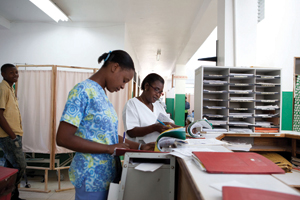 She tires sooner than her friends do and walks slower than they do. She takes no medications. She has not had any surgery. She works in an office. There is no one in her family who bleeds like she does. Smoking is too expensive in Haiti so she does not smoke. Her diet is a typical Haitian diet: rice, beans and local fruits.
She tires sooner than her friends do and walks slower than they do. She takes no medications. She has not had any surgery. She works in an office. There is no one in her family who bleeds like she does. Smoking is too expensive in Haiti so she does not smoke. Her diet is a typical Haitian diet: rice, beans and local fruits.
When she was seen at her first visit to HSC four months ago, she had a normal but very low BP, a pulse in the mid 70 range, pale fingernails and pale sclera of the eyes. The GYN specialist wrote what specialists write. GYN specialists record for a normal uterus: It feels normal in size, is the usual normal pear shape and in correct place in her body.
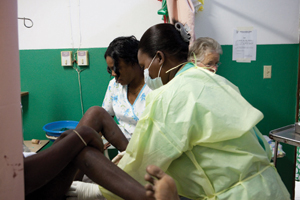 Josette had a blood test and iron level. When the tests were completed she returned that afternoon for the results. They showed a hemoglobin and hematocrit of 8.1 and 27%. The test for iron levels was at basement levels. Her sickle cell test was negative for that disease and the screening test for thyroid showed normal thyroid function. The diagnosis was severe anemia due to gynecologic bleeding.
Josette had a blood test and iron level. When the tests were completed she returned that afternoon for the results. They showed a hemoglobin and hematocrit of 8.1 and 27%. The test for iron levels was at basement levels. Her sickle cell test was negative for that disease and the screening test for thyroid showed normal thyroid function. The diagnosis was severe anemia due to gynecologic bleeding.
Josette was encouraged to eat an iron rich diet and extra daily iron pills. A sonogram was ordered to be performed by a private practitioner in Cap Haitian, Haiti’s second largest city, 10 miles away. Josette lives near HSC so she did not sleep overnight on waiting area benches as some patients with appointments often do. Josette squeezed into a Tap-Tap for her ride home.
First Treatment Results
Josette returned several months later with sono pictures and report in hand. She had taken her iron medicines. The bleeding symptoms were no better. The blood tests for anemia showed some little improvement with the iron pills.
A long term solution was critical. The terms G0 P0 (grava zero and para zero) are short hand medical terms used to designate a woman who has never been pregnant (G0) or borne children (P0). Josette wanted children. Her sonogram showed a thumb like tissue projection called a fibroid had grown slowly over the years into her uterine cavity.
Fibroids are a common benign growth of tissue that occur in a majority of women and requires treatment in less than 4% of the time. The fibroid growth acts like the burr under a saddle or a stone in a shoe. It interferes with normal way the uterus behaves. Remove the burr, remove the stone. Remove the fibroid and the problem is solved. The best answer, the most likely for her treatment in Haiti should be major surgery. This is not a satisfactory one for young women in Haiti who want children. In the United States, many problems like this can be resolved by a commonly used specialized micro surgical or laser equipment and a brief outpatient treatment available in most hospitals or clinics. In Haiti the closest resource is in Santo Domingo, the capitol city of the neighboring Dominican Republic.
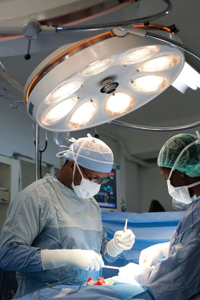 The Case for Expanding HSC Gynecology Clinic
The Case for Expanding HSC Gynecology Clinic
Here in the U.S. the readier cure is a hysteroscopy. The hysteroscope is a straw like instrument with a TV camera and a cutting device at the tip. It is inserted and used to locate and remove the irritating fibroid from inside cavity of the uterus. Removal may not be a cure. Regrowth could occur. It does buy several years time for sure. Unfortunately, no such instrument or expertise is available in Haiti and so Josette is left to choose between her two unsatisfactory choices iron pills with hormones to alter her period or surgery. Because she lives in Haiti, Josette does not have access to the full range of treatment women in developed countries have readily available to them.
So amid the joy of volunteering medical care, there are poignant downers. The need for a HSC based sonogram program is not new. There are changes happening. The need for the program has been recognized and introductory training has begun. A sonogram tech has been designated. There are expert specialists in the U.S. who are willing to help. Slowly ideas are being introduced to develop this expertise and adapt to the resources available in Milot.
A whole support structure is needed. It takes time for the best learner to learn to twist the dials and sono gauges and coax the best views from the machine.
An X-ray space geared to the 1970’s era has to be redesigned, enlarged and refitted. Rugged sonogram machines suitable for Haiti that can be transported to work in outlying clinics are required. A relatively simple data storage record keeping capacity suitable for less developed areas must be designed and put in place. A program similar to U.S. DOD programs that was used in Bosnia several years ago is now being prepared for data transmission back to US experts for interpretation. Looking beyond a hysteroscopy suite/minor OR room will have to be part of future plans to ensure HSC continues to lead in care for Haiti.




